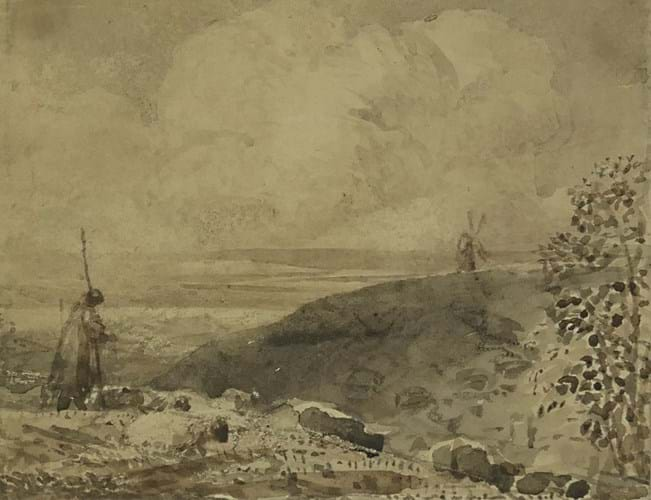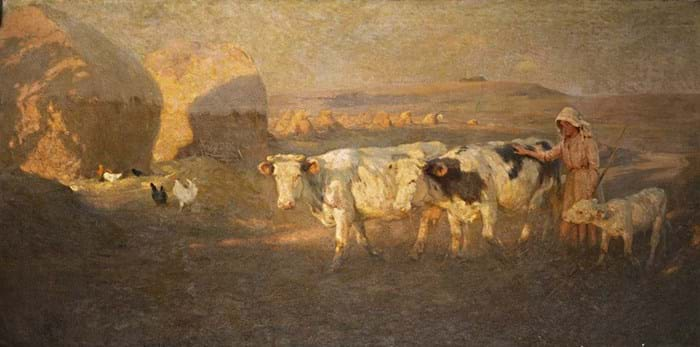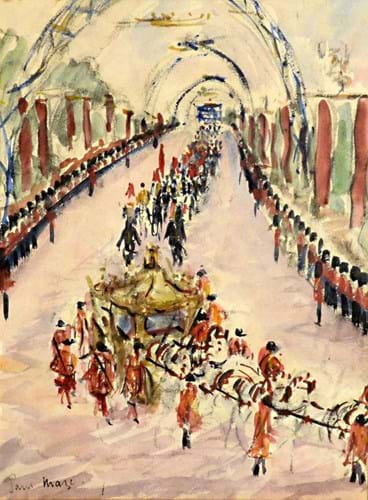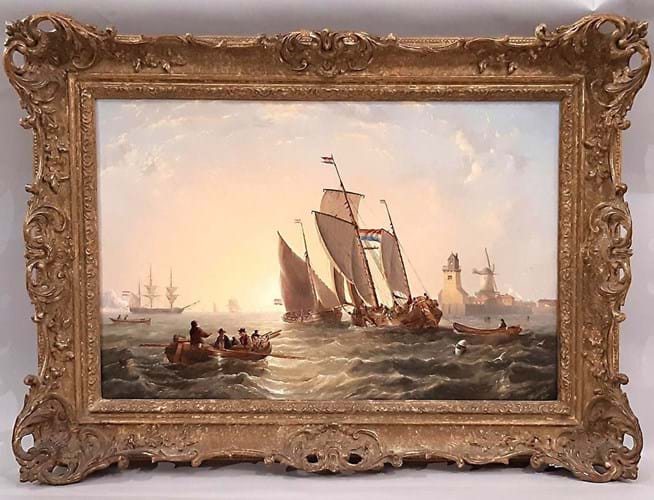Among them was a small but lively work on paper by Sir Alfred Munnings (1878-1959) that came fresh to the market and in good original condition.
The 12½ x 16½in (32 x 42cm) watercolour en grisaille depicted an armed highwayman pursuing a horse-drawn coach. It emerged at Keys’ (22% buyer’s premium) three-day sale in Aylsham, Norfolk, on July 26-28.
Although the subject and medium was slightly removed from the artist’s more familiar and colourful paintings depicting racehorses or country pursuits, they were not unheard of in Munnings’ oeuvre.
A number of monotone pictures – and depictions of highwaymen – have emerged in the last 30 years, although both have tended to make lesser sums than his more trademark works.
This example came to auction from a vendor whose grandmother had received it as a gift along with a Christmas card signed by Munnings and inscribed Christmas 1957 from Alfred M to Nelly with good wishes. Both items were included in the lot which was estimated at £3000-5000.
Offered on the final day of the auction, it drew a battle between a private local collector bidding in the room and another party on the phone. It was knocked down to the latter at £9000 – a decent sum for an unusual work such as this.
Historical interest

The Siege of Seringapatam, and the Fall of Tipu Sultan by William Henry Florio Hutchisson, £6000 at Anderson & Garland.
Meanwhile a week earlier in the north of England a couple of other works on paper with historical subjects drew keen interest.
One was a picture by William Henry Florio Hutchisson (1773- 1857), a British painter known for his scenes of India, depicting the fall of Tipu Sultan during The Siege of Seringapatam in 1799.
The 2ft x 18½in (61 x 47cm) signed watercolour emerged at Anderson & Garland (25% buyer’s premium) in Newcastle on July 19-21.
Dating from 1850, it showed the Tiger of Mysore as an heroic figure (he had often been demonised as a tyrant in earlier British propaganda).
It was one of only a few works by the artist to have come to auction in the last 10 years.
Although his works are rarely available, Hutchisson was an established artist who received plenty of commissions and is sometimes deemed the leading European painter in Bengal after George Chinnery. Indeed, he arrived in Calcutta in the autumn of 1824 just a few months before Chinnery left for China.
Clearly at ease in the local environment, Hutchisson made good money from his portraits in Calcutta and Murshidabad which enabled him to buy two Indigo plantations and live the life of a country squire in colonial India.
Among his most prestigious commissions was a series of portraits of the Nawab of Bengal, one of which is now in the British Library with others remaining in the palace of Murshidabad.
With the artist’s auction record standing at £55,460 for a large oil painting titled The reception of Lord Amherts by Rup Lal Mallick that sold at Sotheby’s back in 1989, this smaller watercolour looked a good bet against a £800-1200 estimate.
It duly caught the eye of a number of bidders and, after strong bidding, was knocked down at £6000.
Another work on paper bringing competition in Newcastle was a watercolour of Queen Elizabeth II’s coronation by Paul Lucien Maze (1887-1979).
The French artist was one of 21 painters officially invited to record the event (others included Edward Seago, Julian Trevelyan and LS Lowry).
The government’s Ministry of Works apparently gave little guidance to the artists in terms of direction, asking them simply to record their individual impressions.
Maze painted a number of scenes including a view of the service at Westminster Abbey and another of the royals on the balcony at Buckingham Palace.
Perhaps his most recognised work from the day, though, was his view of the procession of the Gold Coach of State travelling along the Mall (it was acquired for the government’s art collection).
The smaller 21 x 15in (53 x 38cm) signed watercolour here was part of a group of studies that relate to Maze’s coronation scenes. According to Artprice, six had sold at auction previously with the highest price being the £3500 for an example sold at Christie’s in 1998.
Capturing the splendour and pageantry with broad brush strokes, the current picture was offered together with an official souvenir programme of the event. With this in its favour and with the event much in the mind after Charles III’s own coronation in May, it overshot a £800-1500 pitch and sold at £5500.
Strong competition

Bright Cloud, Shepherd and Windmill, a Samuel Palmer watercolour that made £27,000 at Swan Fine Art.
Perhaps the strongest competition for a work on paper this summer in the regions came at Swan Fine Art (21% buyer’s premium) in Tetsworth, Oxfordshire, on July 12-13.
The Shoreham period watercolour by Samuel Palmer (1805-81) came for sale with a provenance going back to the artist’s wife.
It was then owned by her friend Mrs Bryan Cook and later by her daughter Una Hook before appearing at Godalming auction house Messenger May Baverstock in 1980 and subsequently passing through London dealers Leger Galleries.
The 3½ x 4¼in (9 x 11cm) watercolour and brown wash study was titled Bright Cloud, Shepherd and Windmill and was believed to have been painted in the Kent artists’ colony in c.1831-32.
It was exhibited at the V&A in 1926 and also included in Raymond Lister’s Catalogue Raisonné of the works of Samuel Palmer (1988) as well as Geoffrey Grigson’s Samuel Palmer: The Visionary Years (1947).
Lister believed it was one of five small-scale monochrome studies for The Bright Cloud, a large oil and tempera work on a mahogany panel now in the City of Manchester Art Galleries.
Any fully authenticated Shoreham period Samuel Palmer is a rarity on the market.
This one had previously appeared twice at Bonhams, first in 2007, where it was unsold against a £20,000-30,000 estimate, and then again in 2008 where it again failed against a £15,000-20,000 pitch.
This time it did rather better against a lower £3000-5000 estimate as it sold for £27,000 to an online bidder via thesaleroom.com.
Solid bidding

A young woman herding cattle in a sunlit evening landscape by Frederick Hall, £17,000 at Bearnes Hampton & Littlewood.
Solid bidding also emerged in Exeter on July 11-12 when a large scene of a young woman herding cattle by Frederick Hall (1860-1948) was offered at Bearnes Hampton & Littlewood (25% buyer’s premium).
The 3ft 1in x 6ft 1in (93cm x 1.85m) signed oil on canvas had an inscription on the back reading 7 St Paul’s Studios, West Kensington, which was Hall’s studio address from c.1908.
Although painted in London, the scene depicted was thought to be the Berkshire Downs where the artist settled after his travels through Britain (he went to Newlyn to paint alongside Stanhope Forbes) and Europe.
A similar scene, of equivalent scale, depicting cows, a farmer and a dog in the Lambourn Valley in Berkshire was sold at Dreweatt-Neate in 2000 for £18,500.
While the demand for these traditional rustic scenes has become more selective since then, the fact that the picture here made £17,000 against a £6000-9000 estimate looked relatively strong given the current state of the market. Only five works by Hall have made more at auction in the last 20 years.
Trademark marine scene
In Gloucestershire, meanwhile, a trademark marine painting by John Wilson Carmichael (1800-68) was among the lots attracting attention at Wotton Auction Rooms (18% buyer’s premium) on July 31-August 2. The 15¾in x 2ft (40 x 61cm) signed oil on canvas was dated 1854 and depicted a Dutch coastal scene with a ship’s flag in the country’s colours and a windmill in the background.
The Newcastle-born artist exhibited at the Royal Academy and the Society of British Artists and retains a good following, especially in his native north east.
After moving to London in 1845, he would later travel overseas to cover the Crimean War for the Illustrated London News.
He then spent his final years in Scarborough which, along with Whitby and other Yorkshire coastal towns, were among his most popular subjects.
Although this picture did not feature a north-eastern English subject, it did depict multiple vessels in different positions as well as a rolling sea and an atmospheric sky.
It also came in an ornate gilt frame decorated with scrolling foliage.
Estimated at £1000-1500, it was the first lot of the sale and got the event off to a good start, fetching £4400, a decent mid-range price for the artist.

















